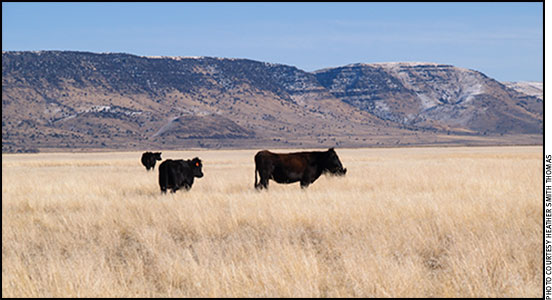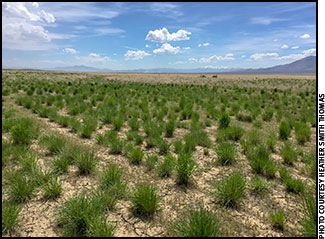
Late-season grazing is one strategy for controlling cheatgrass with cattle.
Control Cheatgrass with Grazing
Grazing helps control invasive grass species.
Cheatgrass has become the dominant vegetation in millions of acres in the West.
“There are indications, with the research we’ve done in conjunction with University of Nevada–Reno, that grazing can help,” says Mark Weltz at the USDA Agricultural Research Service (ARS) Great Basin Rangelands Research Unit in Reno, Nev.
“One tactic is late-season grazing to clean up the old plants and reduce carry-over fuel,” says Weltz. This strips away the litter and mat of dead plants that serve as insulation and protection for the seed bank. A thick mat allows the new seedlings to thrive the next spring. Without that protection, new cheatgrass seedlings don’t establish very well.

Preliminary data have shown that grazing cheatgrass in the spring resulted in 95.8% reduction in cheatgrass fuel loads, while also maintaining perennial grass densities.
“Late-season grazing is only possible for three months out of the year, however, so what can we do the other nine months? There are some other grazing projects we are trying to get funding for, because it’s very expensive to do studies using cattle,” he explains. “We hope to raise a war chest to allow us to do all-season grazing, but not leaving the cattle out there all the time in a single pasture. We still have to move the cattle around the landscape.”
The research team is trying to figure out ways to manipulate the livestock while they are on the pasture and still meet their need for energy, protein, etc., he says. One strategy might be to graze cheatgrass in early spring when it is growing ahead of everything else and when it is green, lush and high in protein. Then, the livestock could be removed to allow the perennials to grow, become stronger, mature and go to seed.
“Then the cattle could come back in the fall and clean up the grass to remove the fuel load and reduce fire risk,” Weltz says.
Preliminary data have shown that grazing cheatgrass in the spring resulted in 95.8% reduction in cheatgrass fuel loads, while also maintaining perennial grass densities. Spring grazing reduces the current year’s fuel load, and significantly reduces cheatgrass seed production and seed-bank densities.
“If cattle could be used as a tool to graze cheatgrass and reduce associated fuels, the reduction in wildfire frequencies could eventually promote perennial species and nearly eliminate cheatgrass. One of the challenges with using cattle as a tool is that a lot of these range allotments are huge,” he adds. “The question is how to control the animals to keep the herd dense enough to graze a certain area to have the same impact as if you ran a lawn mower over the cheatgrass.”
This requires some form of high-density intensive grazing, which means controlling the livestock.
“This is very promising, but do we use electric fence or herders or some other means to keep the cattle grouped?” Weltz asks. “Electric fence is labor-intensive and you have to take it down and move it.”
There’s also the question of water availability for the livestock. This is not flat land or easy terrain for fencing. It would be more logical to have cowboys actively moving the cattle to keep them in the areas you want them.
“This raises the question of how do you find cowboys who want to be like the sheepherders who stayed with their flocks?” asks Weltz.

Editor’s Note: Heather Smith Thomas is a cattlewoman and freelance writer from Salmon, Idaho.






